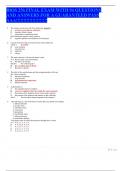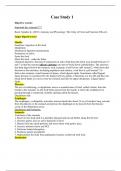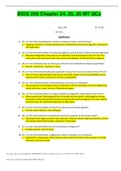Bios 256 digestive system - Study guides, Class notes & Summaries
Looking for the best study guides, study notes and summaries about Bios 256 digestive system? On this page you'll find 69 study documents about Bios 256 digestive system.
Page 4 out of 69 results
Sort by

-
BIOS 256 FINAL EXAM WITH 94 QUESTIONS AND ANSWERS FOR A GUARANTEED PASS AAA
- Exam (elaborations) • 19 pages • 2023
-
- $13.99
- + learn more
1 The urinary system does all of the following, EXCEPT it A secretes excess glucose molecules B regulates blood volume C contributes to stabilizing blood pH D eliminates organic waste products E regulates plasma concentrations of electrolytes 2 Conical structures that are located in the renal medulla are called A pyramids B renal columns C renal pelvises D nephrons E calyces 3 The region known as the macula densa is part of A the proximal convoluted tubule B the distal convoluted t...

-
BIOS 256 FINAL EXAM STUDY Q&A | Comprehensive ATI graded A+
- Exam (elaborations) • 29 pages • 2023
-
- $17.99
- + learn more
BIOS 256 FINAL EXAM STUDY Q&A | Comprehensive ATI 1 The urinary system does all of the following, EXCEPT it A secretes excess glucose molecules B regulates blood volume C contributes to stabilizing blood pH D eliminates organic waste products E regulates plasma concentrations of electrolytes 2 Conical structures that are located in the renal medulla are called A pyramids B renal columns C renal pelvises D nephrons E calyces 3 The region known as the macula densa is part of...

-
BIOS 256 AP 4 Exam Elaborations (highly rated)
- Exam (elaborations) • 35 pages • 2023
-
- $10.89
- + learn more
Week 2: Chapter 24: The Digestive System part two Basic GI Functions Primary function: movement of nutrient molecules from the external environment to the internal environment. (Absorption of nutrients) Food->Digestion->motility and absorption Pancreas Gland in the retroperitoneal space behind the stomach Produces enzymesthat digest carbs, proteins, fats, and nucleic acids Produces the sodium bicarbonate buffer Emptiesthe contents into duodenum Relationship of the Pancreas to th...

-
BIOS 256 Anatomy And Physiology A&P IV With Lab BIOS 256 A&P IV FINAL EXAM REVIEW PACKET 100% CORRECT GUIDE FOR A+ SCORE {ACCURATE SUMMER-FALL SESSION} (Latest UPDATE 2024/2025)
- Exam (elaborations) • 44 pages • 2024
-
- $14.99
- + learn more
BIOS 256 Anatomy And Physiology A&P IV With Lab BIOS 256 A&P IV FINAL EXAM REVIEW PACKET 100% CORRECT GUIDE FOR A+ SCORE {ACCURATE SUMMER-FALL SESSION} (Latest UPDATE 2024/2025) A&P IV Final Exam Review Packet DIGESTIVE PROCESSES 1. Ingestion 2. Digestion (mechanical and chemical) 3. Motility (mixing and propulsion) 4. Secretion 5. Absorption 6. Defecation GI TRACT AND ACCESSORY DIGESTIVE STRUCTURES GI TRACT INNERVATION • Autonomic NS o Parasympathetic...

-
BIOS 256 FINAL STUDY (ATI COMPREHENSIVE FINAL EXAM STUDY)RATED A+
- Exam (elaborations) • 29 pages • 2023
-
- $14.99
- + learn more
BIOS 256 FINAL EXAM STUDY Q&A | Comprehensive ATI 1 The urinary system does all of the following, EXCEPT it A secretes excess glucose molecules B regulates blood volume C contributes to stabilizing blood pH D eliminates organic waste products E regulates plasma concentrations of electrolytes 2 Conical structures that are located in the renal medulla are called A pyramids B renal columns C renal pelvises D nephrons E calyces 3 The region known as the macula densa is part of...

-
BIOS 256: Case Study 1 Digestive system
- Exam (elaborations) • 3 pages • 2024
-
Available in package deal
-
- $8.99
- + learn more
Upper digestive tract Mouth- Functions: Ingestion of the food. Deglutition Mechanical digestion (mastication) Production of saliva. Sense the food. Moist the food – make the bolus. Chemical digestion -Enzyme (Components in saliva help keep the pH in your mouth between 6.5 and 7 so that the enzyme salivary amylase can start to break down carbohydrates. The enzymes that help digest food in the stomach, such as pepsin, work best at a pH around 2, while those that function in the inte...
(GRADED A) BIOS 256 Week 2 Discussion: Peptic Ulcer Disease: A Case on the Digestive System
BIOS-256 Week 1 Discussion: The Digestive System – Pancreas
BIOS 256| EDAPT STRUCTURES AND FUNCTIONS OF THE DIGESTIVE SYSTEM QUIZ WITH ANSWERS| 2024

-
BIOS 256 Coursework Week 1 – 8 BUNDLE | Highly Rated COLLECTION | Download To Score An A
- Package deal • 16 items • 2022
-
- $18.99
- + learn more
BIOS 256 Week 1: Quiz # 1 (View Questions) BIOS 256 Week 1 Lab: Anatomy of the Digestive System Part A: Lab Manual Exercises 1 (Exercise 34) Part B: PowerPhys to #14: Effect of Dietary Fiber on Transit Time & Bile BIOS 256 Week 2 Quiz # 2 (View Questions) BIOS 256 Week 2 Lab: Mechanical and Chemical Digestive System Part A: Lab Manual Exercises 1 (

That summary you just bought made someone very happy. Also get paid weekly? Sell your study resources on Stuvia! Discover all about earning on Stuvia





